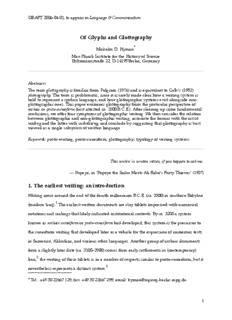
Of Glyphs and Glottography 1. The earliest writing - Archimedes PDF
Preview Of Glyphs and Glottography 1. The earliest writing - Archimedes
DRAFT2006-04-01,toappearinLanguage&Communication Of Glyphs and Glottography * MalcolmD.Hyman MaxPlanckInstitutefortheHistoryofScience Boltzmannstraße22,D-14195Berlin,Germany Abstract: Thetermglottography isfamiliarfromPulgram(1976)andisequivalenttoGelb’s(1952) phonography.Thetermisproblematic, sinceitisrarelymadeclearhowawritingsystemis heldtorepresentaspokenlanguage,andhowglottographicsystemsexistalongsidenon- glottographicones.Thispaperexaminesglottographyfromtheparticularperspectiveof archaicorproto-cuneiform(firstattestedca.3300B.C.E.).Afterclearingupsomefundamental confusions,weofferfoursymptomsofglottographicwriting.Wethenconsidertherelation betweenglottographicandnon-glottographicwriting,associatetheformerwiththeactof readingandthelatterwithverbalizing,andconcludebysuggestingthatglottographyisbest viewedasasinglesubsystem ofwrittenlanguage. Keywords:proto-writing;proto-cuneiform; glottography;typologyof writingsystems Thiswritin’iswrotenrotten,ifyouhappento askme. —Popeye,in‘PopeyetheSailorMeetsAliBaba’sFortyThieves’(1937) 1. The earliest writing: an introduction WritingarosearoundtheendofthefourthmillenniumB.C.E.(ca.3300)insouthernBabylon 1 (modernIraq). Theearliestwritten documentsareclaytabletsimpressed withnumerical notationsandsealingsthatlikelyindicatedinstitutionalcontexts.Byca.3200asystem knownasarchaiccuneiformorproto-cuneiformhaddeveloped;thissystemistheprecursorto thecuneiformwritingthatdevelopedlaterasavehicle fortheexpressionofnumeroustexts inSumerian,Akkadian,andvariousotherlanguages.Anothergroupofarchaicdocuments fromaslightlylaterdate(ca. 3100–2900)comesfromearlysettlementsin(contemporary) 2 Iran; thewritingofthesetabletsisinanumberofrespectssimilartoproto-cuneiform,butit 3 neverthelessrepresentsadistinctsystem. *Tel.:+493022667129;fax:+493022667299; email:[email protected] 1 DRAFT2006-04-01,toappearinLanguage&Communication Thesearchaic textsbelongtoarestrictedrangeofTextsorten,beingconstitutedalmost exclusivelyofadministrativedocuments(recordsassociatedwiththeproductionand transferofagriculturalcommoditiesandmanufacturedgoods;recordsofthedisbursement offoodstuffstoworkers;etc.)andso-called‘lexicallists’ (thematicallyarranged enumerationsofdesignationsforsuchcategoriesasprofessions,places,animals,plants,and 4 manufactureditems). Lexicallistsapparentlyserved thepurposeoftransmittingthe conventionsofthewritingsystemandlaterevolvedintothefirstbilingual(Sumerian- Akkadian)dictionariesinthesecondandfirstmillennia. Althoughsignificantprogresshasbeenmadeinthedeciphermentandunderstandingof thesetextssincetheirpublication(startinginthefirstpartofthetwentiethcentury),crucial aspectsoftheirnatureremaincontroversial.Whilesomescholarshaveregardedarchaic cuneiformaspossessing(atbest)‘weakconnectionsto[spoken]language’(Damerow,1999, 5 2),othershaveseeninthetextscleartiestospokenlanguage. Particularlyvexedis‘the Sumerianquestion’: wasproto-cuneiforminvented(if thatistherightterm)byspeakersof Sumerian(alangueisoléeof theagglutinativetypeknownfromlater cuneiformdocuments) 6 orbyspeakersofsomeotherlanguage? Researchersaddresstwo sourcesinattemptingto answer‘theSumerianquestion’:(1)possible clueswithinthecorpusofproto-cuneiform tabletsthatunequivocallyindicateSumerianphonology,morphology,syntax,orlexicon;(2) evidencewithinattestedSumerianforthepresenceofasubstratelanguage,indicativeofan 7 aboriginalpopulation. Inwhatfollows,Iamnotconcernedwiththe‘Sumerianquestion’ perse.Rather,Iwishtoexplorethecriteriabywhichweidentifycertainwritingas glottographic(i.e. representingspokenlanguage),andtoanalyzetherelationbetweenwriting andspeechinbothpastandpresentcontexts. 2. Signal confusions 8 9 10 Sampson(1985, 29)divideswriting into glottography,whichrepresents spokenlanguage, 11 andsemasiography,whichrepresentsideationalcontentdirectly. Yetsemasiographyisnota 2 DRAFT2006-04-01,toappearinLanguage&Communication felicitousspecies:instancesofsemasiographyareunifiedonlybythefactthattheydonot notatespokenlanguage(thenotchesonthehandleofakiller’sknife,anilliteratepirate’s treasuremap,theicononthepapershredderthatwarnsmetokeepmynecktieatasafe distance,brandmarksontabletsofEcstasy,adiagramofafinitestateautomaton,Wilkins’ 12 ‘realcharacters’). AsPlatofamouslyobserved,thedichotomybarbarian/Greekleadspeople totheerroneousbelief thatthereisanaturalclassofbarbarians,whoexemplifyasharedset offeatures(Politicus262d–e).Iproposethatthetermsemasiographyisasvacuousasbarbarian —andthatbotharisefromunexaminedprejudices.Itisbetterthatweemploythesimple designationnon-glottographic. Certaintypologists(e.g.Hill, 1967;cf.Coulmas,1996)denythepossibilityofnon- glottographicwriting. Forthem,allwritingisfundamentallylinguistic—evenso-called 13 BildschriftandSachschrift(cf.Gelb,1952,4–6). SinceIdonotwishtogetboggeddownhere inwhatismeantbytheterm‘linguistic,’Iproposesimplytodefinewritingasnon- glottographicif (1)itcanbereadwithsimilarfacilitybyspeakersofdifferentlanguages, or (2)itsreadinghasthecharacterofparaphrase(i.e.twodifferent‘readings’arelikelyto employsignificantdifferencesinwordchoiceorsyntactic construction). Insomeaccountsofnon-glottographicwriting,however,spokenlanguagesneaksinbythe backdoor.Witness:‘Graphsofthissort[i.e.non-glottographic]mapdirectlyontotheworld ofrealthings,andreadingthemisatwo-stepprocessthatproceedsfirstfromGRAPH toTHING orACTION[…]andthenfromTHING/ACTIONtoNAME ofthing/action,thatis,toLEXICALMEANING’ (Boltz,2000,1–2). Theclaim(behindwhich oneistemptedtoseeanaïveHumboldtianism orbehaviorism)isthattoread suchsigns,wemustmapthemontoverbalconcepts.WhenI receivemyshirtbackfromthedrycleaner,Iseetheyellowsmileyfaceonthehanger;I picturearealface[cf.Boltz’s‘worldofrealthings’]—smiling;Ithinkofthewords‘smile’ (andperhaps‘Haveaniceday!’). Thisscenarioissurelytobediscounted;rather,thehappy faceleadsmebypriorassociationstoaparticularpsychologicalstate,withperhapsboth cognitiveandemotionalcomponents;verballanguageisnotneeded(whichisnottosay 3 DRAFT2006-04-01,toappearinLanguage&Communication thatwedon’toftenverbalizewhenconfrontedwithsignsorthings).Also—andthisisa pointtowhichIshallreturn—theverbalizationsthatmayarisewhenweareconfronted withthesignarenot predictable andnotfixedinrelationtothesign. Iemphasizethedividebetweennon-linguisticsignsandlinguistic conceptsbecause scholarsofearlywritingfindthemselvesalltoooftenintheprison-houseoflanguage. Considerthefollowingstatement,fromareputabletextbookofAkkadian: Functionally,signsintheirearlieststagewerelogographic,i.e.they representedoneormorespecificwords.Apurelylogographicwriting systemispersenotboundtoanyspecificlanguage:givenasequence ofpicture-signsrepresentingTHREE,SHEEP,GIVE,TEMPLE,agivensocial contextmightenableoneto‘read’(addingformalmodifications unexpressedinthewritingsystem)inEnglish‘threesheepweregiven tothetemple’orinFrench‘onadonnétroisbrebisautemple’as adequatelyasonecould‘read’suchatextinSumerian.(Caplice, 1988, 5) Theconfusionhereisremarkable.Theauthoridentifiesalogogramascorrespondingtoone ormorewords,butthendeniesthatlogographicwritingisglottographic!Ifproto-cuneiform exhibitsthelooseconnectionclaimedherebetweenasequenceofsignsandanutterancein aparticularlanguage(andsomeevidencesuggeststhatitdoes),thenproto-cuneiformisnot glottographic.Outsidelanguagetherearenowords(and,hence,nologographicwriting). 3. Symptoms of glottography InthissectionIidentifyfourcategoriesthatmightberegardedassymptomsofthe dependenceofawritingsystemonspokenlanguage.Iintroducetheseingeneraland summarizetheirapplicabilitytothecaseofproto-cuneiform. 3.1 Phonography 14 Byphonography,wemeanthenotationofspeechsounds. Obviouslysyllabariesand alphabets(includingdefectivealphabetsthatrecord onlyconsonantsounds;theseare 15 sometimescalledabjads)arephonographic. Sotooarethehybridsemi-alphabetic scripts usedinSouthandSoutheastAsia(Vaid,2002;Sproat,2000,45).Butasystemsuchas Chinese—inwhichcharacters(字zi4)representmonosyllabicmorphemes—alsopossesses 4 DRAFT2006-04-01,toappearinLanguage&Communication aphonographicaspect.InChineseorthography,manycharactersarecomplexesgenerated fromasemanticradicalandaphoneticcomplementthatindicatesthepronunciation.Thus 楓feng1‘maple’isanalyzedas木mu4‘tree’+風feng1‘wind’.AndsoaChinese reader recognizesthat楓referstoatree (radical ontheleft)thatispronounced likethewordfor wind(phoneticontheright).Thephoneticcorrespondenceneednotbeexact.Thatsuch phoneticcompoundingisrecursiveaccountsforitsastonishingproductivityinChinese 16 writing(80%ofcharactersemploythedevice );thusthephoneticof 楓(i.e.風‘wind’) is furtheranalyzedas虫hui3‘insect’+凡fan2‘all’(Mattingly&Hsiao,1999;Sproat,2000,49– 50;cf.Martin,1972;Yin,1994,21–25).(Admittedlythisanalysisisphoneticallyand semanticallylessperspicuousthantheformer;theevolutionofwritingsystemstendsto introducesomemeasureofopacity;cf.Halliday, 1981,128.) Thereislimitedevidenceforphonographyintheearliestproto-cuneiform,fromtheUruk 17 IVa/IIIperiods(ca. 3200–3000B.C.E.). Thistakestwoforms.First,putativerebusreadings, suchasTI‘arrow’(pictogramofabowandarrow) usedfortheSumerianhomophone‘life, tolive’,inarchaicspellings(EN E TI )ofthecommonformula(d)En.lil .ti‘mayEnlil give a 2a a 2 18 life’. Second,putativephoneticcomplements,similartothosejustdiscussedforChinese: 19 e.g.GA ×EN readMEN‘crown’;EZEN×ENreadEZEN ‘feast’ratherthanthevariantfor 2 x theformersign, BAD ‘wall,enclosure’(Steinkeller,1995,694–695;Glassner,2003,145). x Third,putativesyllabicspellings:e.g.MAŠ+GAN fortheAkkadianloanmaškanu 2 20 ‘threshingfloor;smallagriculturalsettlement’(Steinkeller,1995,695;Glassner, 2003,161); GAL+KIN forKINGAL‘headoftheassembly’(Glassner,2003,146;N.B.thereversed 5 21 spelling). 22 Notoneoftheseexamplesisuncontroversial. Evenamongscholarswhoacceptthe evidenceforphonographyinthearchaicscript,itisacknowledgedonlythat‘thereseemsto 23 beasmallamountofphoneticwritinginproto-cuneiform’(Cooper,2004,80). 3.2 La chaine de la parôle 5 DRAFT2006-04-01,toappearinLanguage&Communication Althoughnaturallanguagesyntaxcompriseshierarchical relationships(representedbytrees ingenerativegrammar),speechisrealizedasalinearsequenceofwords(orofmorphemes). Weexpectaglottographicwritingsystemtoencodespeechasastringofgraphemes.This stringmustbeaccommodatedtothetwo-orthree-dimensionalsurface uponwhichitis 24 inscribed(e.g.bymakingprovision forline-breaks); butthedominantprincipleisthat graphemesarearrangedin anorderthatcorrespondstotheirlicensingelementsinthe 25 temporalchainofspeech. (Thoughthelettersofane.e.cummingspoemsprawldrunkenly downthepage,theirarrangementisdeterminedinlargepartbyacodethatexistsin additiontotheglottographicone—Howtoreproducethearrangementorally?) Proto-cuneiformtabletsexhibitastructurethatbearsvirtuallynoresemblancetonatural- languagesyntax.‘Syntax[…]wasscarceornon-existent.Individualentriesandsummary remarkswereenclosedincases(rectangularboxes)ontablets,andthesecasescouldbe arrangedinverticalcolumns, butwithincasestheplacementofsignswasarbitrary,except thatnumeralscamefirst’(Cooper,2004,81).‘Thepositionofthesignswithinthetextswas determinedtoalesserextentbycriteriarelatingtolanguagesyntaxthanbythe“tablet format.”Thislayoutwasspecifictoparticulareconomictransactions;itdeterminedhow andwhereagivenbitofinformationwastobedisplayed.[…]Thevarioustabletsfromthe earliestphasesofwritingthereforebearcloserresemblancetosuchmoderndocumentsas punchedcards, dockets,clearingchecks,balancesheetsormanyotherformalizeddata carriersthantoindependentlyandfreelycomposedmanuscriptsinthemodernsense’ 26 (Nissenetal.,1993,30). Lexical lists(which comprisemorethan10%oftheproto-cuneiformcorpus)followa columnarformatwhereeachcasecontains(1)thesignN ,whichhasthevalue‘1’inthe 1 sexagesimalnumericsystem(thesignseemsheretoservemuchthesamepurposeasthe modernbulletindemarcatingthebeginningofanentryinalist),and(2)oneormoresigns correspondingtoadesignationofthecategorywithwhichthelist isconcerned(e.g.a 27 profession,nameofacity, typeofanimal,etc.). 6 DRAFT2006-04-01,toappearinLanguage&Communication Aphenomenonconcomitantwiththe(neartotal)absenceofnaturallanguagesyntaxisthe absenceofgrammatical functionwordsandmorphs.Signsonadministrativetablets correspondgenerallytonumericnotations,saliententitiessuchasagriculturalproductsand disbursements,andadministrativetitles/names.Therelevantactionsaregenerallytobe inferredfromthedocumenttype.OnlybytheUrperiod(ca.2800)arethereclearlyreliable indicationsofSumerianfunctionmorphs(Cooper,2004,80). 3.3 Formal characteristics Whatistheformofglottographicwriting?Inasuperficialsense,itisaline:left-to-right(for English),right-to-left(forHebrew),top-to-bottom(forMongolian), boustrophêdon(i.e. alternatingdirection:left-to-right,thenright-to-left,etc.)inthecaseofseveralpaleographic 28 traditions. Sometimeswritingfollowsadifferentcurveinordertoaccommodateitself to itsmaterial:thusaninscriptionaroundtherimofaplatewill followthecircumference. Onlyrarelydoesglottographytransfigureitselfcompletely,intosomethinglike Apollinaire’sCalligrammes,orthecalligraphic rendition ofsūra105oftheQur’an(al-Fīl)that takestheformofanelephant. Letusbeginwithontogeny.Howdochildrenwrite,beforetheyhavebeentaught?Atthe firststage,thereisundifferentiatedwriting(Tolchinsky, 2003,56–62;Gibson,1972,12). Childrenatthisstagearecapableofdistinguishingbetween(whatconstitutesfortheir culture)writingandnon-writing.Whentheywrite,words(orothersalientlinguistic units) maynotbeidentifiable; yetwefindsomecriticalfeatures:‘linearity, presenceof 29 distinguishableunits, regularityofblanks,anddirectionality’(Tolchinsky,2003,58). These featuresdifferentiatewrittenlanguagefrompictures; similarly,formalconfigurations distinguishwrittenlanguagefromnumericnotations.Childrenwhohavenotyetlearnedto readwill rejectstringsofrepeatedtokensas‘goodforreading’(e.g.AAAA),butwillallow themaspotentialnumericalnotations‘goodforcounting’(e.g.2222)(Tolchinsky,2003,152– 157). 7 DRAFT2006-04-01,toappearinLanguage&Communication Formreachesmuchdeeper,however.Inthe1930sand40sGeorgeKingsleyZipfdiscovered anumberoffactsaboutthedistributionofitemsinlanguage.Bestknownis‘Zipf’sLaw,’ whichstatesanexpectedrelationbetweentherankorderofawordinatextanditsfrequency. Aword’srankisitsmeasureoffrequencyincomparisonwithotherwords(sothattheword withrank1isthemostfrequentwordinthetext;thewordwithrank2,thesecondmost frequent;etc.);aword’sfrequencyisthetotalnumberofoccurrencesofthewordinthetext (orsample).Zipf’slawpredictsthatinatext/sampleofsufficientlength,thefrequencyof wordswill followaharmonic series, suchthatthewordwithrank2occursapproximately halfasoftenasthatwithrank1,thewordwithrank3occursapproximatelyonethirdas oftenasthatwithrank1,andsoon.Thustherank-frequencypointswilllieonornearthe hyperbolic curverf=C,whererisaterm’srank,fitsfrequency,andCisaconstant.When plottedondoublylogarithmicscales, thiscurvewill appearasalinewithslope=-1(Zipf, 1949,19–55). Thepredictionhasrepeatedlybeenshowntoholdtrueforwordsintext samplesdrawnfrommanylanguages,periods,andgenres.Asanillustration,FIGURE1plots 30 therank-frequencyrelationinaLatintextofthe16thcentury. Theproto-cuneiformcorpusconsistsofca.5820tablets, whichcontainca.42000signs, 31 excludingnumericsigns(Englund,1998, 65). Thesetokensrepresent 1618signtypes provisionallyidentifiedasdistinct,althoughtheworkondecidingwhich signforms 32 representmereallographsandwhich aregraphemicallydistinctisbynomeanscomplete. Ifwetreattheentirecorpusasasinglesample,wecanplotsignsbyrank-frequency,aswe 33 didabove(FIGURE2). It isimmediatelyevidentthattheplotdifferssubstantiallyfromthat expectedforwordsinanaturallanguage;inparticular,asrankincreases,frequency decreasesconsiderablymoreslowly.Thisresultisnotsurprising,as(1)thereisnoreasonto supposethatproto-cuneiformsignsrepresentwords, and(2)ithasnotbeendemonstrated thatproto-cuneiformisinfactglottographic. Ontheotherhand,thedistributionofproto-cuneiformsignsbroadlyresemblesthe distributionofmorphemesinanaturallanguage(seeZipf,1949,87–97). Bycomparison,we 8 DRAFT2006-04-01,toappearinLanguage&Communication shalllookataclassical Chinesetext.TheChinesewritingsystemisoverwhelming morphosyllabic, inthatitscharacters(字)typically representmonosyllabic morphemes (Ramsey,1989,58–59;Yin,1994,311–312;cf. supra,§3.1).Thustherank-frequency distributionofChinesecharactersisverysimilartothatofnatural-languagemorphemes 34 (FIGURE 3). Thesimilaritybetweentheproto-cuneiformandChinesedataisstriking.Yetof course,wecannotconcludethatproto-cuneiformsignsrepresentmorphemesinanatural language;all wecanconcludewithsafetyisthattheirdistributionandfunctioningisin certainrespectsakintonaturallanguagemorphemes. Oneaspectofthisfunctional similarityisthatsignsarecombinedtoformnames/titles,suchasKUŠIM(KU+ŠIM), apparentlyanadministrativeofficialnamedoneighteentabletsoftheErlenmeyercollection 35 (Nissenetal.,1993,36–46). Likewise,qualifieddesignationsinvolvesigncombinations wherethecomponentsmightbethoughtofas‘morphemic’(regardlessofwhetherwetake thearchaictextsasbeingglottographicorasbeingcomposedinapurelywritten Sondersprache):e.g.KUR+AMAR‘bullcalf’, SAL+AMAR‘heifercalf’,AB +GA‘milkcow’, 2 AMAR+GA‘suckling(calf)’(Nissen etal.,1993,89). 3.4 Mediation Inapassagethathasbeenquotedtothepointoftedium,Aristotledeclaresthatwritten wordsarethesignsofspokenwords,which inturnarethesignsofpsychological states(De interpretatione16a4–6).That,ofcourse,isastatementaboutglottography. Non-glottographic writinglacksthemediationofspokenlanguage;itsnotationsarethemselvessignsof 36 psychologicalstates.Proto-cuneiformsignsdepictthings, butbeyondtheobjectthatis moststraightforwardlydepicted, thereliesasemanticconstellation:‘apictogramcanrelate tootherrealities, attachedtothesameobjectbymentalprocessesthataremoreorless foundedinreality, ordownrightconventional,andperfectlywellknownandutilizedinthe 37 representationofart’(Bottéro,1992,76). Newsignscanbecreatedfromexistingsignsby producingtableaux;forinstance,SAG‘head,person’+NINDA‘rationingvessel’(a pictogramofabeveled-rimbowl)yieldsGU ‘disbursement(offoodrations)’, which comes 7 9 DRAFT2006-04-01,toappearinLanguage&Communication eventuallythroughtheineluctableprocessofsemanticchangetomeansimply‘eat’(Nissen etal.,1993,14–15).Writing,however,differsfromthefigurativeartsinthatiteschews particularsandseeksratherthegeneric,theuniversal,theuniform,theconventional (Bottéro,1992,77).Whenasignisdrawnagain,itisnotanewpicture,butratheranother instanceofthesamesign.Justastheformofthesignbecomesstereotyped,sodoesits semantics.Thesignisnownolongerinterpretivelyopen-endedinthefashionofapicture; rather,itbecomeslimitedtoafewconventionalusages(onepresumesthatthelexical lists playedaroleinthisprocess). Thisgeneralizationofformandfunctionallowsusto distinguishnon-glottographicwritingfrompicturesandothermanifestationsofthe figurativearts,andallowsustospeaknotincoherentlyofnon-glottographicwriting systems. Thelastpoint,however, isevidentlycontroversial. Unger&DeFrancisassert,bluntly,‘[a] semasiographicwritingsystemisacontradictioninterms’(1995,53). Theirargumentisnot thatnon-linguistic signsareimpossible perse,butratherthattheycannotserveasthebasis foracommunicativesystembecause:(1)picturesarenotself-explanatory, and(2)awriting systemcouldnotbedevelopedwithoutrecoursetospokenlanguageforthepurposeof 38 descriptionandexplanation. Totheformer,wemayquotePettersson: ‘DeFrancisisof courserightinthatpicturesarenotunderstandablebythemselves—ittakesacultureto 39 explainthem,namelytheverycultureinwhich theywereproduced’(1996,51). Tothe latter,IshoulddoubtthatanyonebelievestheUrukscribesdidnotspeakamutually intelligible languageamongstthemselves.Butitissenselesstoassertthatrecoursetoa spokenlanguagefortheexplanationandteachingofawritingsystemmakesthatsystem glottographic;weshouldthenbeobligedtoclassifyvirtuallyalltechnologyaslinguisticin nature,becausehumansrelyonspokencommunicationinitscreationanduse. 4. Glottographic and non-glottographic writing Theevidenceavailable atpresentseemsinsufficienttomakeacleardiagnosisof 10
Description: